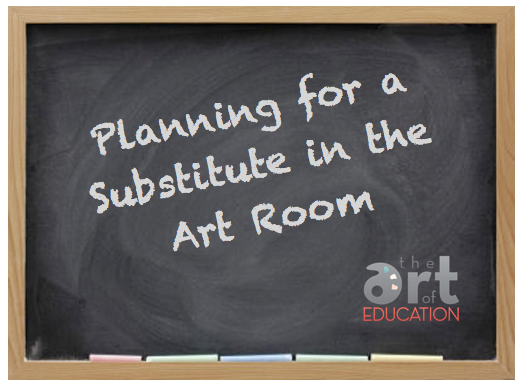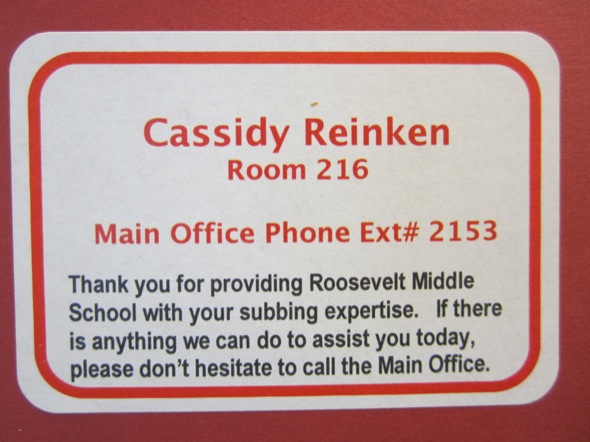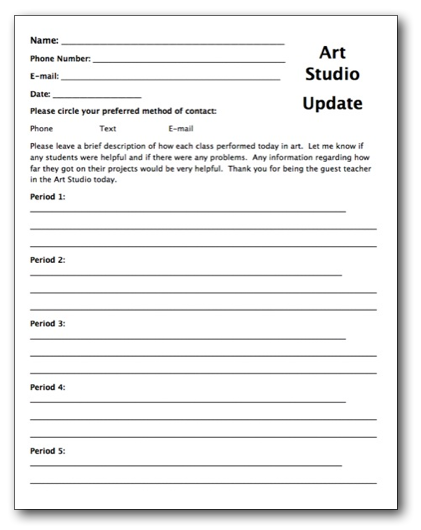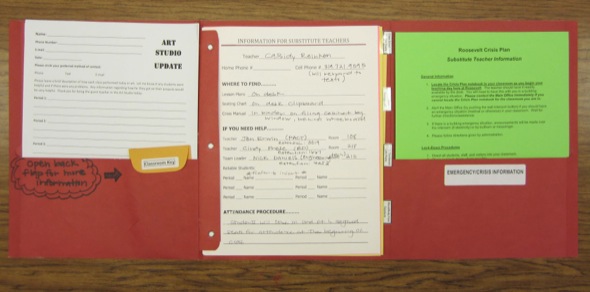Do you have your substitute teacher plans ready to go this school year? Often times this job gets pushed aside until you really need it, which can leave you scrambling. This upcoming week we will be covering “Planning for a Substitute in the Art Room” all week long! Visit AOE each day for different ideas and things to consider when planning for a substitute teacher (and even some tricks you have never thought of before) specifically for the art room. You won’t want to miss it!

In the first article of the week we will talk about creating a folder for your substitute!
My teaching career began as a substitute teacher. The more information the teacher left me, the more comfortable I felt and coincidently the less behavior problems I had. As a teacher, I try to leave as much information for my substitute teachers as possible. I give them the tools they need and it’s up to them whether or not they use them.
Our school has building wide sub folders that our secretaries made. Inside the two pockets folder is three prongs where there are various pages containing information about my classroom and the school. The dividers inside include information about class Schedules/ seating charts, classroom management, early dismissal/late starts, and blood/body fluid exposure. One pocket has information regarding emergency and crisis procedures. There is a sticker with computer log in information. The second pocket has an art studio update form.
If your school doesn’t proved sub folders, I suggest you create your own and keep in your classroom. Each folder contains building wide information that is inside the folder when we receive them. Then, it’s up to each teacher to add information pertaining to our classroom.
How to Create Your Own Sub Folder
1. Label the Outside of Your Folder
On the outside of the folder is a sticker with my name on it, my room number and the main office phone number. Our secretaries are amazing. They are truly two of the nicest women I have ever met. They included the following note; “Thank you for providing Roosevelt Middle School with your subbing expertise. If there is anything we can do to assist you today, please don’t hesitate to call the Main Office.” How welcoming is that?

2. Include a Classroom Key
Our classroom keys are kept inside our folders in a small envelope. This way the substitute teachers can use the key and place them back inside the folder. (Your school probably has a policy on passing out keys; this is how our school chooses to pass them out.)
3. Include an Information Sheet
The information sheet is similar to the table of contents in a book. It provides the basic information such as my name, my home phone number and my cell phone number. (I added a note saying I will respond to text messages.)
Below the contact information is a section that titled “Where to find…” This tells where to find items such as lesson plans, seating charts, and crisis manual. All of these items can be found on my desk. If you aren’t sure of how to get your lesson plans to your substitute teacher, look for an article later this week where I will share my secret. There is a “If you need help..” section that has other teacher’s names and phone numbers as well as a list of reliable students. There is also an “Attendance Procedure” section where I explained how they can take attendance. (Most of this information is included in detail in the following pages of the folder.)
Sections of my Sub Folder:
- On the left side of the photo are the Art Studio Update (see sample below) form and my classroom key.
- The center of the folder is the information sheet and on the far right is a crisis information sheet.
- The first page of this section is my daily schedule.
- The second page is a list of reliable students. I choose two students per class. I will switch out this page next quarter and replace with new list.
- The third page discusses my seating chart information. Here is what I wrote on this page. “See the clipboard on Mrs. Reinken’s desk for seating chart information. Students need to sit in their assigned seats. If you would like to make comments regarding the seating chart, please use the post it notes. Please don’t write on my seating chart.” Sometimes my students try to tell substitute teachers that they’re allowed to move seats, so this clears the confusion about that. I write on my seating chart in pencil to allow for changes to be made in seats. Last year I had a substitute teacher write on my seating chart in pen and it drove me crazy. The post it notes will allow them to make their own notes
- Classroom Management section: Inside this section I included information about attendance, chairs (my students take down and put up), where their artwork is stored, how I expect the floors and counters to look at the end of class, my policy on gum, my policy on talking, and how many minutes to give for cleanup. I also included information about my behavior expectations and included the dates I have morning and after school duty.
- Early Dismissal/Late Start Section: This section contains our early dismissal and late start schedules. You could include any other information that pertains to early dismissals or late starts in this section.
- Body/Blood Fluid Exposure: This section has a hand out summarizing the precautions when dealing with bodily fluids.
I created an Art Studio Update form that I leave for substitutes to fill out. It is a quick form so they can let me know where the students left off. This gives me an idea of how much progress my students made on their project or what activities they worked on.
Here is an example of my Art Studio Update form:

You can also include some lesson plans or one day projects that students can work on.
Do you have a substitute folder?
What else do you keep in your substitute folder?
Magazine articles and podcasts are opinions of professional education contributors and do not necessarily represent the position of the Art of Education University (AOEU) or its academic offerings. Contributors use terms in the way they are most often talked about in the scope of their educational experiences.





